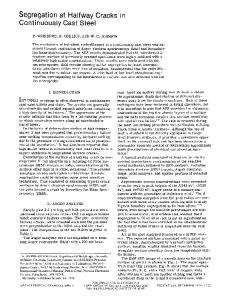Quantitative Characterization of Inclusions in Continuously Cast High-Carbon Steel
- PDF / 4,370,684 Bytes
- 13 Pages / 593.972 x 792 pts Page_size
- 89 Downloads / 307 Views
INCLUSIONS in steels are oxides or sulfides or ‘‘composite’’ inclusions and can be exogenous and indigenous. Exogenous inclusions are those formed as a result of erosion or corrosion of different materials such as refractories and slags, whereas indigenous inclusions are formed as a result of de-oxidation and/ or de-sulfidation practices, re-oxidation of the melt, and precipitation during solidification and solid-state cooling.[1] Improved practices have greatly reduced the size and amount of non-metallic inclusions remaining in molten steel and steel products. Cast products are subjected to different hot deformation processing depending on their applications. The size, size distribution, and the maximum inclusion size in a given volume of steel are particularly important for clean steels. Inclusions in clean steels consist of few large particles and many small ones. Mechanical properties are influenced by the size, composition, and distribution MASOUMEH FARAJI, Research Fellow, formerly with the University of Sheffield, Sheffield, U.K., is now with the Materials and Engineering Research Institute at Sheffield Hallam University, Sheffield, U.K. Contact e-mail: [email protected] DAVID P. WILCOX, formerly Researcher and EM Specialist with the Tata Steel R&D, Rotherham, U.K., is now Field Service Engineer with the FEI UK Ltd, Cambridge, U.K. RICHARD THACKRAY, Lecturer, and IAIN TODD and PANOS TSAKIROPOULOS, Professors, are with the Materials Science and Engineering Department, The University of Sheffield, Sheffield, U.K. ANDREW A. HOWE, formerly Visiting Professor with the Materials Science and Engineering Department, The University of Sheffield, is now Consultant with the Beta Technology, Doncaster, U.K. Manuscript submitted April 16, 2013. METALLURGICAL AND MATERIALS TRANSACTIONS B
of inclusions. The hard and brittle oxides are usually the most harmful. Thus, there are very good reasons to understand the nature of inclusions and the effects of processing on their morphology and distribution, and ultimately their effect on the properties of steel. Evaluation of steel cleanliness requires determining the location and chemistry of inclusions in a steel. Depending on application, different criteria are set and different methods are used to serve this purpose. Almost all existing standards for the characterization of inclusions are designed for wrought alloys. Metallographic techniques, which are widely used for characterizing inclusions, are based on optical microscopy and scanning electron microscopy (SEM). There are well-known standards to perform characterization of inclusions using optical microscopy, some of which are based on standard Chart Comparison, for example SS111116,[2] or the ‘‘German Standard of Microscopical Examination of Special Steels for Non-Metallic Inclusions’’ (VDEh 1570–71),[3] which involve comparing the sample with a series of images in chart form. Another common standard is the ASTM E 45-97, ‘‘Standard Test Methods for Determining the Inclusion Content of Steel.’’[4] Alongside the manual methods of analysis, ther
Data Loading...











